‘An incredible building’: Conservation team completes second project at Norman Towers
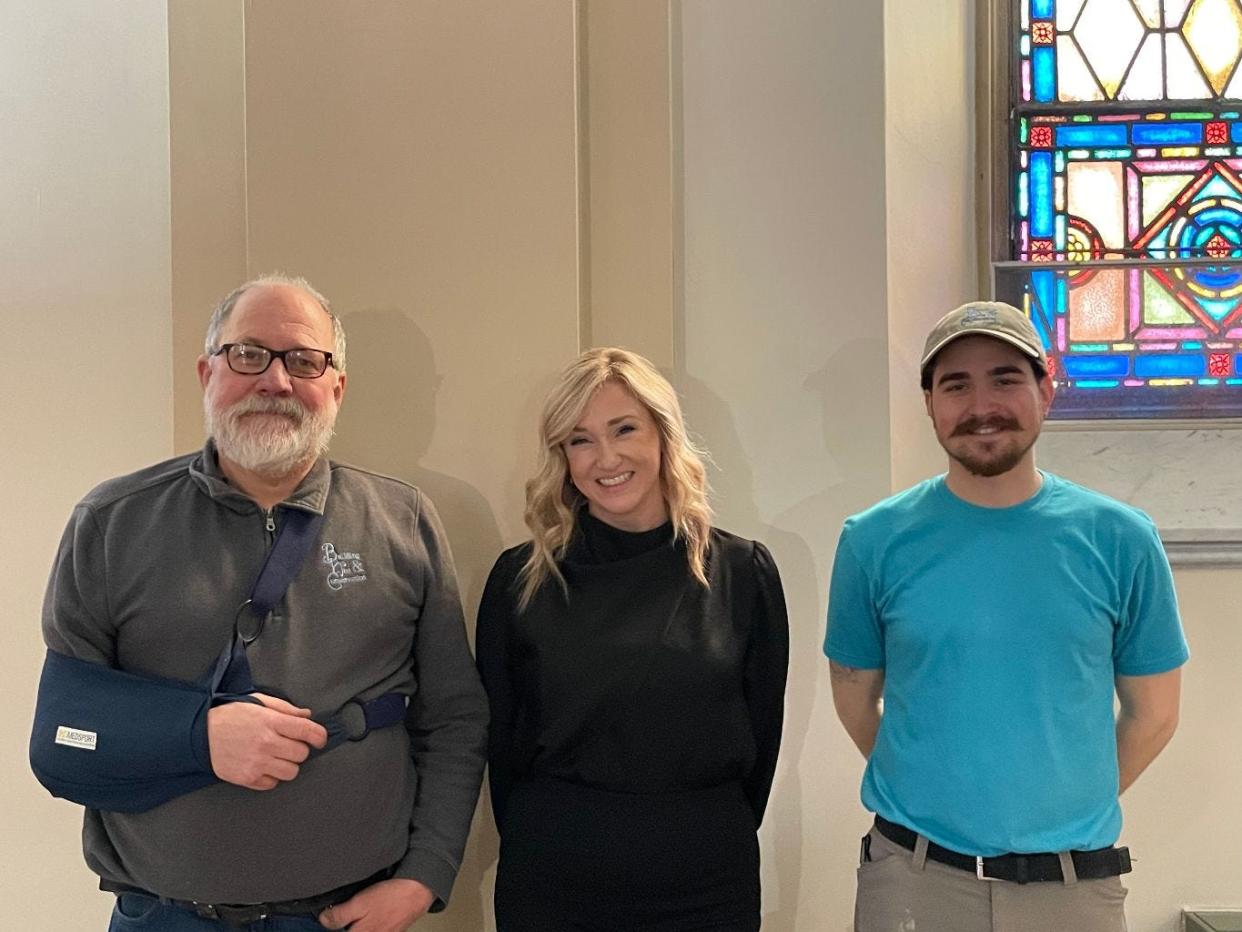
Sometime after 1919, Hall of the Divine Child got new chandeliers in its chapel. The school's light fixtures are still in use today at Norman Towers.
“They can be considered Neo-Jacobean, with some Tudor Revival influence. The chapel chandeliers were certainly installed relatively early. We are not sure the precise year (they) were installed. A 1919 photograph shows different ones were present soon after the school opened. As far as I know, however, we do not know why these earlier fixtures were changed out for the ones that are now there,” Ron Koenig, architectural conservator, said.
Koenig owns Building Arts & Conservation of Saline, and historic buildings are his specialty.
The conservator and his team just finished their second restoration project at Norman Towers, the 109-unit independent senior living complex on Elm Avenue, which was once a military school for boys. Koenig has also worked on other local historic sites.
Koenig first came to Norman Towers in 2017 and was impressed with the 105-year-old structure and its upkeep.
“This is an incredible building. It wows you. It was the only military school for young boys in the Midwest,” Koenig said.
But, like most historic buildings, restoration is needed over time, and water damage is common.
“The greatest enemies of historic buildings, they say, are man’s mistakes and water,” Koenig said. “But they’ve been good stewards of the building. The residents love the fact that they get to live in a building that’s so wonderful.”
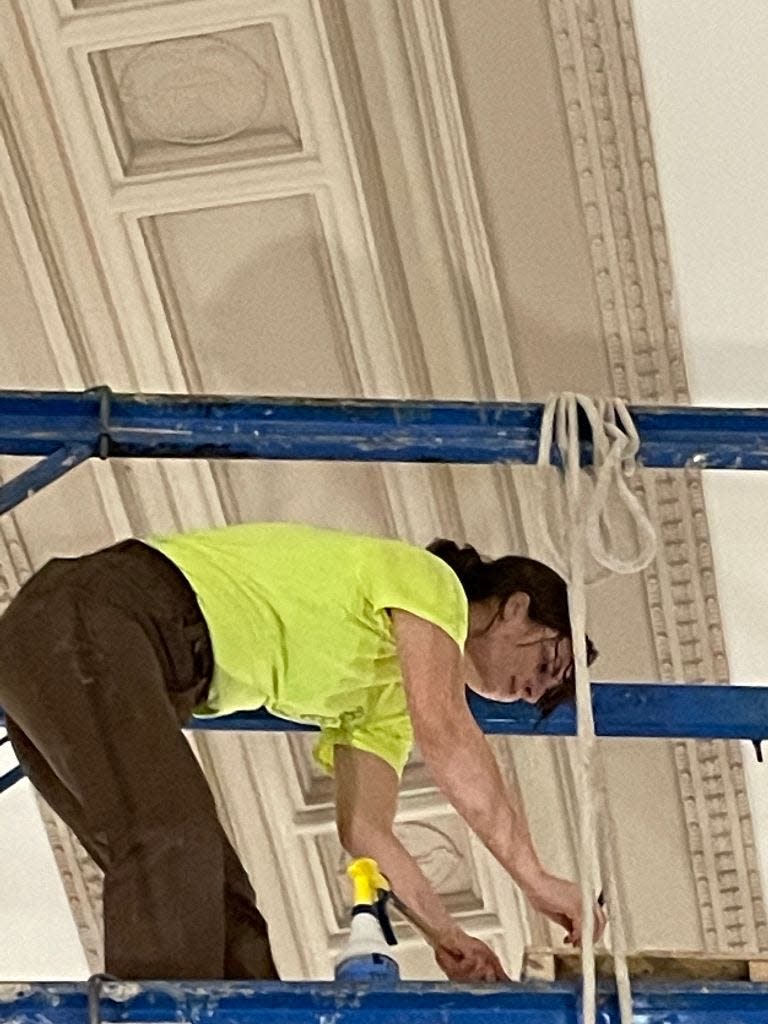
Koenig's first project at Norman Towers was in 2017-18 and included upgrades to the electrical and work in the living quarters. He also restored the copper front doors.
This time, Koenig worked mainly in two public areas with his six-member team of artisans, conservationists and skilled tradespeople. The crew worked on the front entryway and in the school’s former chapel, which is now used as a dining hall/community room.
Often their work requires what Koenig calls “reverse engineering.”
“Figuring out how they did something,” he said.
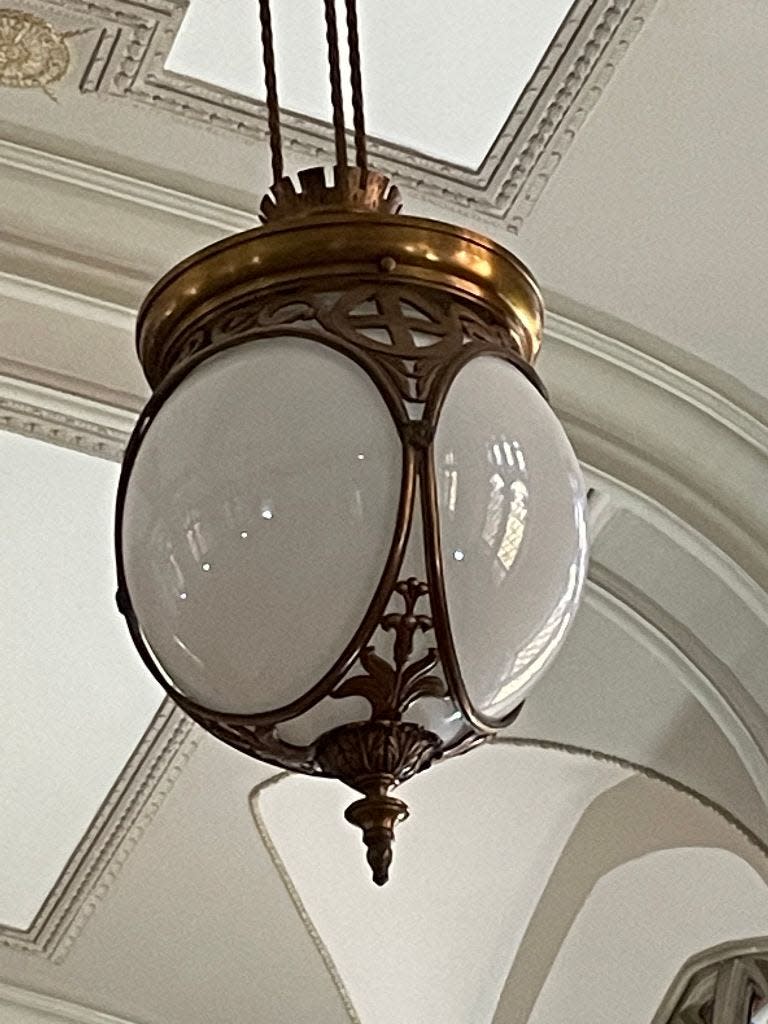
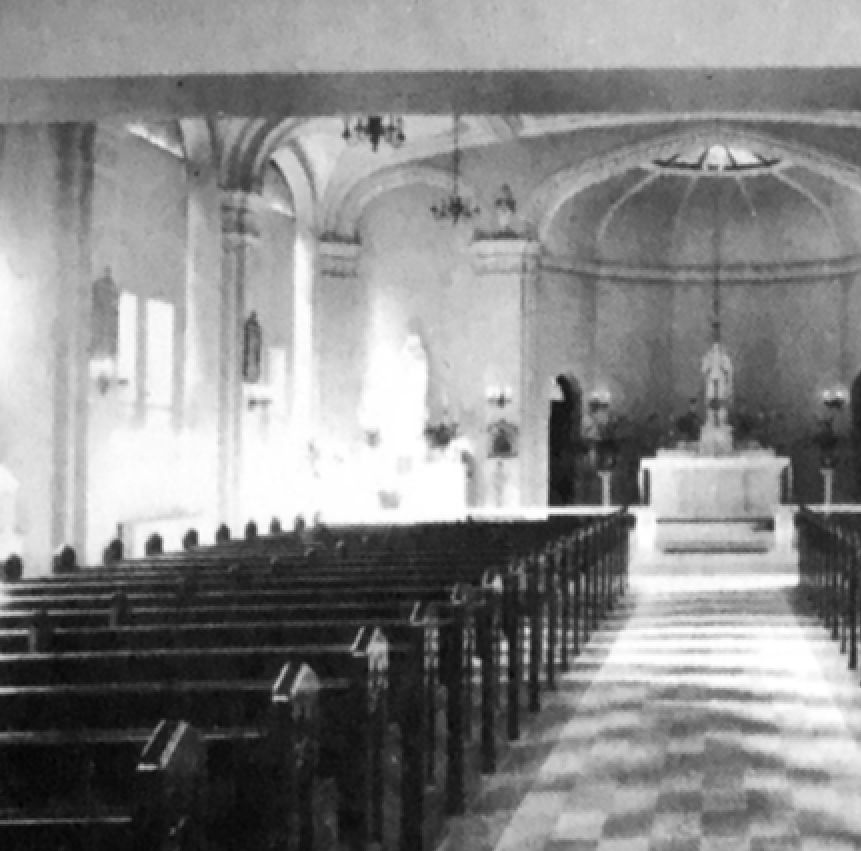
That was the case with the community room’s chandeliers. The fixtures had an old electrical system. The lights all appeared to be connected in a series.
“I am not an electrician. As I understand it though, when a group of lighting fixtures is connected in series, all components on the circuit are hooked up end-to-end, and the same amount of current flows through all of them,” Koenig said.
For help, he called electrician Ron Ely of Monroe.
“He is a good friend who worked as an electrician for Ford Motor Co. for many years. We often speak with him for advice on electrical matters,” Koenig said.
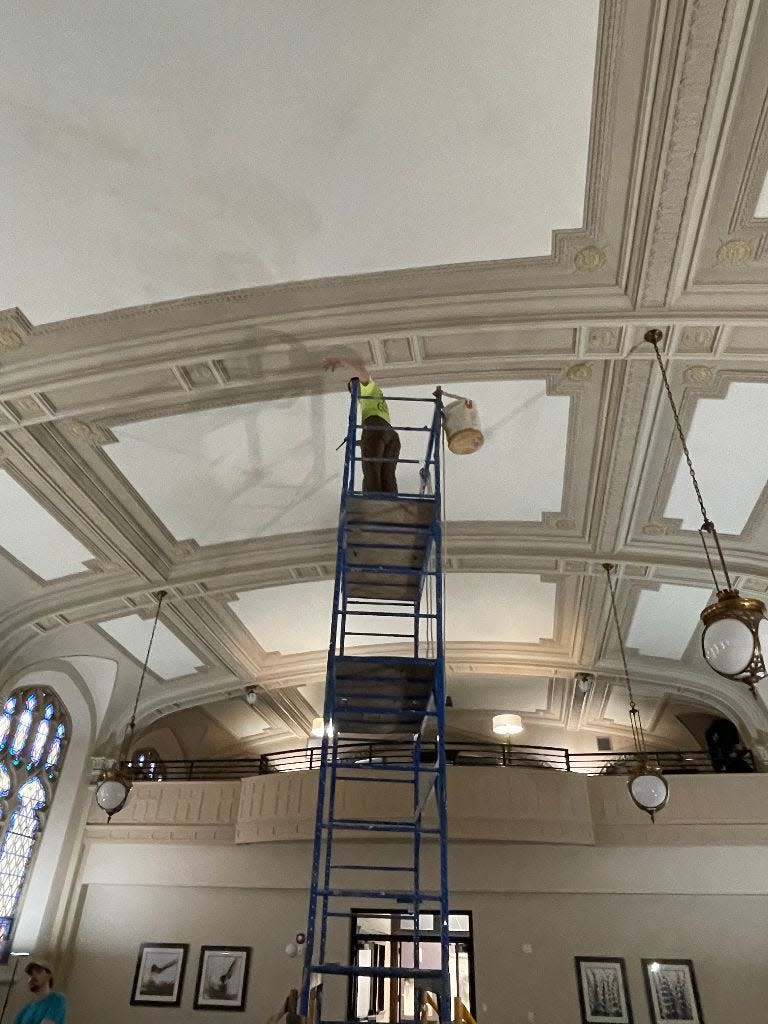
The community room lighting project included changing light bulbs twice.
The chandeliers originally used SBMV, or self-ballasted mercury vapor bulbs, which are known for long life spans.
“An electrical engineer I spoke with said he thought these bulbs had been in place for a very long time,” Koenig said.
During his previous work at Norman Towers, Koenig swapped out the old SBMV bulbs for LEDs.
“It took awhile to figure out how they were powered and how we would retrofit the fixtures with LEDs, because these lights are unusual,” Koenig said.
This time, Koenig replaced the LEDs with dimmable, high-output LED bulbs.
“This technology has changed dramatically in the last few years, so we are now replacing these old LEDs with LEDs that will be fully dimmable. This will now allow Norman Towers to keep the lights at lower or higher levels according to how the space is being used by the residents,” Koenig said.
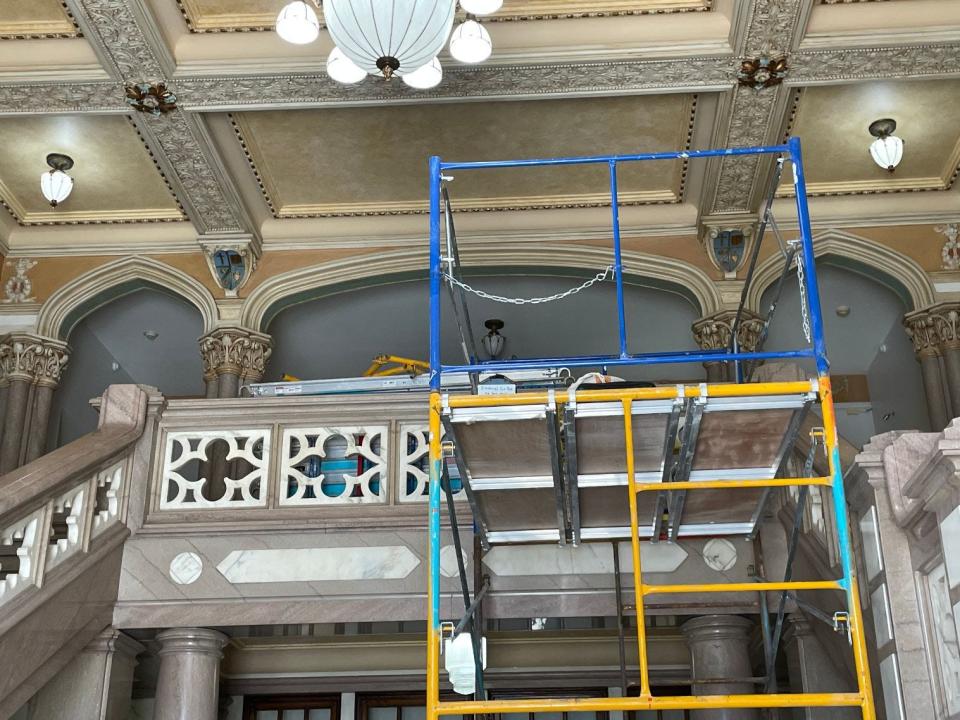
For the last 30 years, Koenig’s Building Arts & Conservation staff has conserved historic buildings and their architectural features, such as plaster, wood, paint, metallic leaf, glazes, stencils and glass. The company frequently works on structures listed on the National Register of Historical Places.
Hall of the Divine Child/Norman Towers was added to the registry on April 17, 2017, and was cited for its architecture, local significance and former educational use.
“They have strict ways to get on it. When you’re on the list, you have access to historic preservation tax credit dollars. The registry is now for homes. It changes the whole landscape of the neighborhood,” Koenig said.
Koenig's work has brought him to Monroe several other times. He’s worked at the 1860 Papermill School at the Navarre-Anderson Trading Post, a project that included renovation of the exterior brick, conservation of the classroom’s original chalkboard and light fixture restoration. In 2004, he helped restore and conserve spaces inside the Sisters, Servants of the Immaculate Heart of Mary Motherhouse, including the grand entry and the chapellete. He’s also worked at the Monroe County Museum.
Koenig got started in the field when he was 30.
“In 1988-89, I did the State Capitol. You can’t go up from there. It was a major restoration. I said, 'This is what I need to do.’ I went to the University of Pennsylvania to study material science and conservation,” Koenig said.
He’s been a conservator ever since. Once, he traveled more, but today, he finds enough work in Michigan. He’s worked on projects at Eastern Michigan University, the Detroit Athletic Club, the Edsel and Eleanor Ford House and Henry Ford Museum. This fall he worked on the University of Michigan’s Rackham Auditorium.
“It’s a great job,” Koenig said.
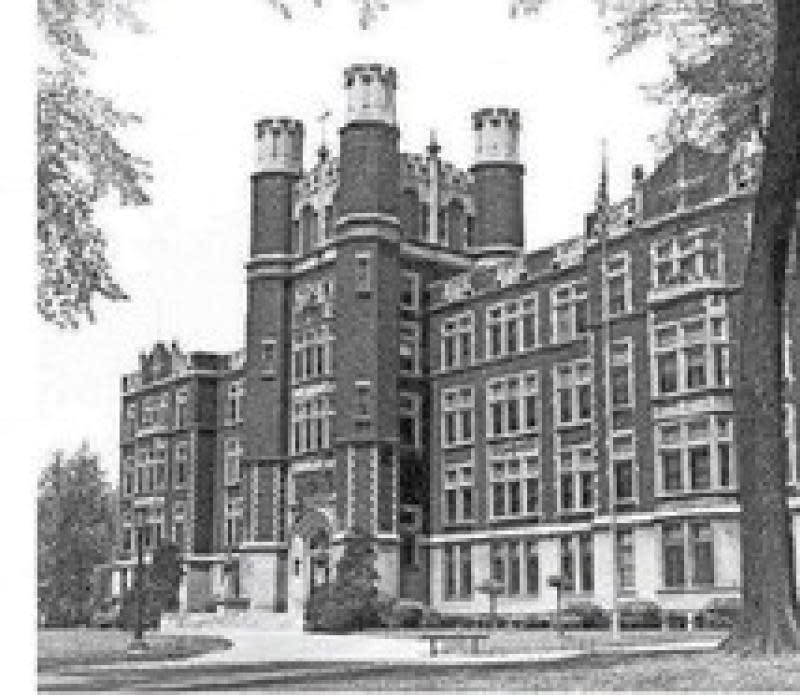
Norman Towers’ history
In the early 1910s, according to The Monroe News archives, Mother M. Mechtildis, Mother Superior of Sisters, Servants of the Immaculate Heart of Mary, had the idea to build a school for boys. Until then, the IHM had only educated girls.
Construction work on the school began in 1916, and the project cost an estimated $300,000.
“It will exceed in beauty and size the present college building and will be the finest building in Monroe,” reported a Monroe Evening News story from 1916. “Those who visited the site have been amazed at the size of the proposed building.”
The school was designed by noted Detroit-based church architect Harry J. Rill. His four-and-a-half story red brick, Tudor-Gothic structure includes features like turrets, limestone, quoins and Tudor arches.
Work was expected to be completed in September 1917, but World War I caused delays. Hall of the Divine Child opened in January 1918. The first class had 18 students.
The Sisters named the school “Divine Child” in reference to the child Jesus.
Hall of the Divine Child educated boys in primarily first- through eighth grades, although older students were admitted briefly before World War II. A military program was added in 1936. Girls were admitted for a short time in the 1920s. In its heyday, more than 300 attended and were taught by IHM sisters.
In the 1970s, enrollment began to decline, and the IHM closed Hall of the Divine Child in 1980. The Sisters said if the building was not sold, it would likely be demolished.
Eventually, companies from Ann Arbor and Southfield were hired to develop the property, and it reopened as Norman Towers. “Norman” refers the building’s Norman architecture.
In 1984, Norman Towers’ first tenants moved in.
At a glance
Other local sites on the National Registry of Historic Places:
Dundee Historic District
North Maumee Bay, Erie
George Armstrong Custer’s Equestrian Monument
East Elm-North Macomb St. Historic District
Gov. Robert McClelland’s House in Monroe
Navarre-Anderson Trading Post
Old Village Historic District in Monroe
St. Mary Church Complex Historic District
Weis Manufacturing Co. in Monroe
Detroit River Light Station in Rockwood
This article originally appeared on The Monroe News: Conservation team completes second project at Norman Towers

